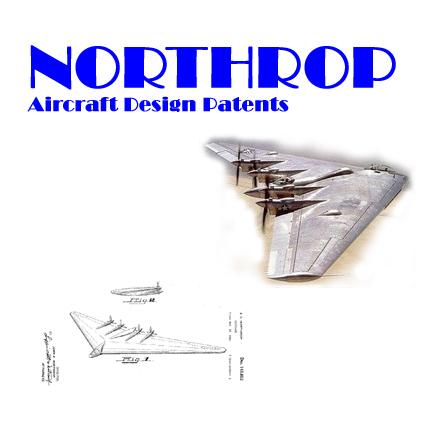
Home of the Flying Wing
Northrop Aircraft Patents

Join Us on Facebook
John Northrop's Enduring Vision
Our treatment of aircraft began as an account of my trials and tribulations in building a 1948 airplane model kit. Since then, we have developed a wealth of patent diagrams and other data for historic aircraft. The page became so large that it was very slow to download. On November 25, 2009 we split the material into six segments, corresponding to the six boxes or "buttons" below. These smaller pages should download very quickly.
If you came in from a search engine looking for something very specific, click here for the Analytical Index that will enable you to find a specific topic.
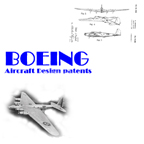
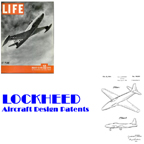
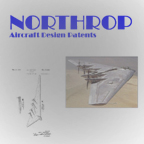

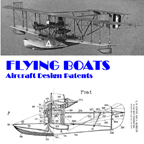
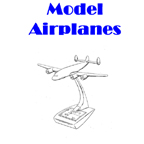
Hello! This page presents some of John Northrop's visionary patents. Since you may have come here with a specific purpose, here are some helpful shortcuts
About the Northrop Company- Northrop N1-M Experimental
- Northrop P-62 Black Widow Night Fighter
- Northrop XP-56 Black Bullet Experimental Fighter
- Northrop XB-35 Flying Wing Bomber
- Northrop F-89 Scorpion Fighter
- Northrop SM-62 Snark Cruise Missile
- Northrop F-20 Tigershark Fighter
- Northrop B-2 Spirit Bomber
This is part of a general Retro Lifestyle/Swing Dancing website. We have a Guide to 1940s Treasures and a Swing Dance Calendar for Washington DC.. Please feel free to Contact Us if you'd like to comment on the golden age of balsa wood models.
Northop Aviation
John K. Northrop formed Northrop Aircraft Corporation in 1929. Based in California, the company was a division of United Aircraft and Transport Corporation which was part of the Boeing conglomerate (above). Northrop's reputation began with the Alpha (first flown 1930), the first all-metal stressed skin airplane. This was followed by the 1939 Beta, the first airplane to exceed 200 mph. The New Northrop Corporation was formed after the forced breakup of the Boeing conglomerate. Douglas Aircraft was the majority shareholder. Northrup produced the successful Gamma high-speed mailplane in 1933. In 1939, John Northrop established an independent company to concentrate on military projects, including the A-17 attack-bomber and P-61 Black Widow nightfighter. Northrop experiments with the tailless XP-56 interceptor led to a number of postwar flying-wing projects, culminating in eight jet-engined YB-49 flying-wing bomber of 1947. The F-89 Scorpion all-weather fighter entered production two years later, serving USAF and Air National Guard Units until 1963. Extending its activities into other fields, the company changed its name to Northrop Corporation in the year 1959. In May 1994 Grumman and Northrop merged to form Northrop Grumman Corporation.
Northrop N1-M Experimental
In 1940 the Northrop N-1M, an all-wing design was developed to test John Northrop's theories about flying wings. It was powered by two Lycoming engines driving pusher propellers.
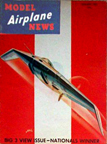
Northrop N-1 Experimental
Model Airplane News Cover Art for January, 1942
by Jo Kotula
Click to Enlarge
The N-1M was a true all-wing design and its low drag gave improved acceleration in both dive and glide; it also enabled the aircraft to use significantly less power on take-off than conventional aircraft of similar size and weight. Early tests found few problems, the main one being engine cooling, but this was solved by the installation of Franklin engines with almost double the power along with three-bladed propellers.
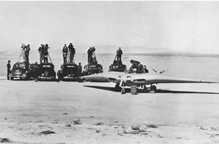
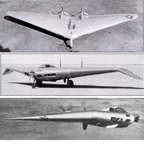
Northrop N1M Experimental Flying Wing
Click to Enlarge
The N-1M has survived and may be seen in the US National Air and Space Museum.


Northrop N-1M Flying Wing
Design Patent D-143,853
Click to Enlarge
Click Here to learn how to get free patent diagrams
Here is a video that has extremely rare color footage of the first flight of the N1M:
Click Here for more information about the Northrop Flying Wing program.
Northrop P-62 "Black Widow" Night Fighter
The Northrop P-61 Black Widow was the first operational U.S. military aircraft designed specifically to use radar. The "Black Widow" was an all-metal, twin-engine, twin-boom, aircraft flown as a night-fighter by United States Army Air Forces squadrons in the European Theater, the Pacific Theater, the CBI Theater, and the Mediterranean Theater during World War II.
On the Cover of Model Airplane News
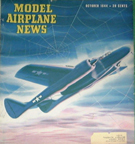
Northrop P-62 "Black Widow"
Model Airplane News Cover for October, 1944
by Jo Kotula
Click to Enlarge
It replaced earlier British-designed night-fighter aircraft that had been updated to incorporate radar when it became available.


Northrop P-61 Black Widow Night Fighter
Click to Enlarge
On the night of 14 August 1945, a P-61B-2 of the 548th NFS named "Lady in the Dark" was unofficially credited with the last allied air victory before VJ Day. The P-61 was also modified to create the F-15 Reporter, the last piston-powered photo-reconnaissance aircraft designed and produced for the U.S. Air Force.


Patent Diagrams for the Northrop P-61 Black Widow
Design Patent D-144,211
Click to Enlarge
Click Here to learn how to get free patent diagrams
Here is an Army Air Corps Training Film for the P-62.
The Cleveland model airplane company made a contemporaneous detailed scale model kit of the "Black Widow".
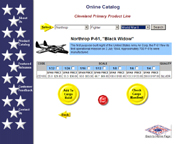
Northrop P-61 "Black Widow" at the Cleveland Site
You can buy the plans and patterns that will enable you to make this model right now. Click Here to go to the exact location on the Cleveland Website to get them.
Click Here for more information about the P-61 Black Widow.
Northrop XP-56 "Black Bullet" Experimental
The XP-56 was Nothrop's entry in a 1939 competition for innovative fighter designs. The XP-56 was a tailless and used welded-magnesium construction. One prototypes was ordered in 1940 and another in 1942. Power was provided by a 2,000hp Pratt & Whitney radial engine that drove contra-rotating pusher propellers. It was intended to be armed with two 20mm cannon and four 12.7mm machine guns.
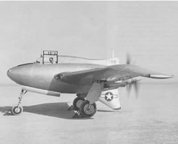
Northrop XP-56
The Black Bullet"
Click to Enlarge
The first tests were conducted in late 1943. The first prototype was destroyed in a landing accident after only two flights. The second prototype was modified to remedy the problems and flew in early 1944. Control and power problems abounded. After the 10th flight the Army concluded that further flight testing was "too hazardous" and development was discontinued.


Patent Diagrams for the Northrop XP-56
Click to EnlargeDesign Patent D-143,864
Click Here to learn how to get free patent diagrams
Here is some footage from test flights of the XP-56
Click Here for more information about the XP-56 Black Bullet.
Northrop XB-35 "Flying Wing" Bomber
Aviation pioneer John Northrop spent decades developing the concept of an all-wing aircraft, trading the weight and drag of a conventional fuselage and tail for greater speed and range.
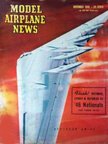
Northrop XB-35 "Flying Wing"
Model Airplane News Cover Art for November, 1946
by Jo Kotula
Click to Enlarge
Such a design, not needing a conventional fuselage and tail assembly, would produce much less drag as it moved through the air. The air resistance thus saved could in turn be traded for significant advantages: higher speed, or the ability to carry a greater load at much greater ranges. With no need to confine most of the payload within a narrow and heavily-stressed fuselage, that weight can be evenly distributed across most of the lifting surface, resulting in a lighter and more efficient structure. Northrop devoted much of his career to proving that the all-wing concept could be used in a practical aircraft.
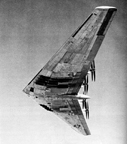

The Northrop XB-35 Flying Wing
Click to Enlarge
The Flying Wing was a romantic concept for science fiction writers as illustrated in this article in Popular Mechanics:

The Flying Wing as a Concept
From the February, 1938 issue
Click here to read the entire article
Click to Enlarge
Aviation pioneer John Northrop spent decades developing the concept of an all-wing aircraft, trading the weight and drag of a conventional fuselage and tail for greater speed and the ability to carry a greater load at much greater ranges. With no need to confine most of the payload within the fuselage, the weight can be evenly distributed across most of the lifting surface, resulting in a lighter and more efficient structure.

Popular Science Takes You Inside the Flying Wing
From the January, 1947 issue
Click here to read the entire article
Click to Enlarge
Northrop devoted much of his career to proving that the all-wing concept could be used in a practical aircraft.


Patent Diagrams for the Northrop XB-35
Design Patent D-143,852
Click to Enlarge
Click Here to learn how to get free patent diagrams
Here is a video about the XB-35 that combines stock footage with animation.
The XB-35 was plagued by mechanical problems of a fairly minor but embarassing nature. Political considerations played a role in the selection of the B-36 (which was almost the diametric opposite of the XB-35) as America's strategic bomber for the Post-WWII era.
CENTER>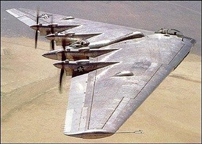
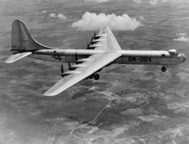
XB-35 vs B-36
The B-36 is almost all fuselage!
Click to Enlarge
Eventually, Northop's vision was vindicated in the B-2 "Spirit", America's strategic bomber for the 21st Century (See below for details.
Click Here for more information about the Northrop Flying Wing project.
Northrop F-89 "Scorpion" Fighter
The Northrop F-89 Scorpion was an early American jet-powered fighter designed from the outset as an all-weather interceptor.
On the Cover of Model Airplane News
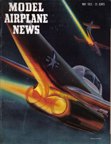
The Northop "Scorpion"
Model Airplane News Cover for May,1952
by Jo Kotula
Click to Enlarge
Though its straight wings limited its performance, it was among the first USAF jet fighters equipped to fire guided missiles, including the distinction of being the first combat aircraft armed with nuclear weapons (the unguided Genie rocket) for air-to-air use.
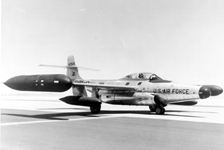
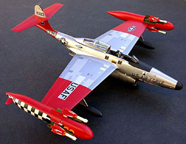
Northrop F-89 Scorpion
(left) Initial Configuration (right) Final Configuration
Click to Enlarge
Northrop submitted four different designs, (including yet another radical flying wing). They settled on the N-24, a slim-bodied aircraft with a cantilevered mid-mounted wing and two Allison J35 turbojet engines with afterburners. It was to have radar and a crew of two, with an armament of six 20 mm (.79 in) cannon in a rotating nose turret. One of the unusual aspects of the design was the use of Northrop's "Deceleron", a combination aileron/dive brake/flap that could be accommodated in the slim wing design. This became a Northrop trademark and is still used today on the B-2 Spirit. Contracts for two prototypes were issued in December 1946. The initial XP-89 prototype made its first flight in 1948.


Patent Diagrams for the ="Northrop F-89 Scorpion
Click to EnlargePatent Nos 2,665,084 and 2,706,431
Click Here to learn how to get free patent diagrams
The first F-89A entered USAF service in September 1950. It had AN/APG-33 radar and an armament of six 20 mm cannons with 200 rpg. The swiveling nose turret was abandoned, and 300 gal fuel tanks were permanently fitted to the wingtips to add range, given the exremely thin wing. Underwing racks could carry 16.5" aerial rockets or up to 3,200 lb of bombs
Here is a video with some early footage of the F-89:
Click Here for more information about the F-89 Scorpion.
Northrop SM-62 "Snark" Cruise Missile
The Northrop SM-62 Snark was a specialized intercontinental cruise missile with a nuclear warhead operated by the US Strategic Air Command from 1958 until 1961. It takes its name from Lewis Carroll's snark, a very ambitious fictional monster with very little sense of humor. It is included here because John Northrop's development of remotely actuated controls for the Flying Wing project made it possible to separate the pilot from the plane altogether. Previous aircraft had actual wires, pulleys, etc that were connected to the pilot's controls. The specialized needs of the Flying Wing required a system whereby the pilot signalled his intentions with the controls, but the actual mechanical manipulation of the ailerons, flaps, elevators, etc was done by automated systems incorporating feedback.
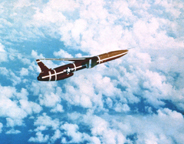
The Northrop SM-62 Cruise Missile
It has a strong similarity to today's Tomahawk Missile
Click to Enlarge
The Snark was developed to offer a nuclear deterrence to the Soviet Union at a time when ICBMs were still in development. Work on the project began in 1946. Budget reductions threatened the project in its first year, but the intervention of Jack Northrop and Air Force Chief of Staff Carl Spaatz saved the project. Despite this, funding was low and the program was dogged by requirement changes. So many Snarks were fired down the Atlantic Ocean Test Firing Range that the crews referred to them as "Snark Infested Waters."

Patent Diagrams for the Northrop SM-62 Cruise Missile
Click to EnlargeDesign Patent D-174,466
Click Here to learn how to get free patent diagrams
The expected due date of 1953 passed with the design still in testing and SAC was becoming less enthusiastic. In 1955, President Eisenhower ordered top priority to the ICBM and associated missile programs. A few missiles went into active service, but by 1961 the Snark was abandoned as obsolescent.
Here is a video showing the launch and flight of a "Snark":
However, history demonstrated the prophetic nature of John Northrup's vision, as cruise missiles descended from the Snark are a major component of the US Arsenal today.
Click Here for more information about the Northrop SM-62 "Snark".
Northrop F-20 "Tigershark" Fighter
The F-20 Tigershark was designed and built by Northrop as a privately financed light fighter. Its development began in 1975and featured a new engine and powerful and flexible radar that gave the pilot "beyond visual range" air-to-air capability. The F-20 was capable of firing most U.S. weapons and missiles. The F-20's performance was competitive with the F-16 Fighting Falcon, but was it much less expensive to purchase and operate.
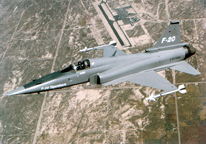
Northrop F-20 "Tigershark"
Victim of Policy Whims
Click to Enlarge
Much of the F-20's development was under the Carter Administration's "Project FX", which limited fighter sales to less-advanced models to prevent front-line U.S. technology from falling into Soviet hands. Northrop had high hopes for the F-20 in an "FX" market. However, the Reagan Administration scrapped "FX" and left the F-20 competing for sales with front line fighters like the F-16. The F-20 development program was eventually abandoned in 1986 after three prototypes had been built and a fourth partially completed.
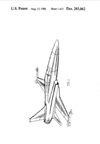

Patent Diagrams for the The Northrop F-20 "Tigershark"
Design Patent D-285,062
Click to Enlarge
Click Here to learn how to get free patent diagrams
Here is a video featuring the F20 "Tigershark":
Click Here for more information about the Northrop F-20 "Tigershark".
Northrop B-2 "Spirit" Bomber
The Northrop Grumman B-2 Spirit (also known as the Stealth Bomber) is an American heavy bomber with "low observable" stealth technology designed to penetrate sophisticated anti-aircraft defenses and deploy both conventional and nuclear weapons. Because of its considerable capital and operations costs, the project was controversial in Congress and among Pentagon brass. During the late 1980s and early 1990s'
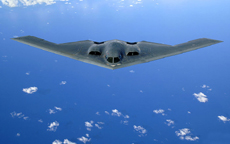
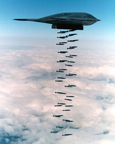
Northrop B-2 "Spirit" Bomber
Click to Enlarge
The cost of each aircraft averaged $737 million in 1997 dollars. Total procurement costs averaged $929 million per aircraft, which includes spare parts, equipment, retrofitting, and software support. The total program cost, which includes development, engineering and testing, averaged US$2.1 billion per aircraft (in 1997 dollars).
Twenty B-2s are operated by the United States Air Force. Though originally designed in the 1980s for Cold War operations scenarios, B-2s have been used in combat to drop bombs on Serbia during the Kosovo - Serbia Conflict in the late 1990s, and see continued use during the ongoing wars in Iraq and Afghanistan.[4] One aircraft was lost when it crashed on takeoff in 2008.
The bomber has a crew of two and can drop up to 80 500 lb-class JDAM GPS-guided bombs, or 16 2,400 lb B83 nuclear bombs in a single pass through extremely dense anti-aircraft defenses. The B-2 is the only aircraft that can carry large air to surface standoff weapons in a stealth configuration. The program has been the subject of espionage and counter-espionage activity and the B-2 has been prominent public spectacles at air shows since the 1990s

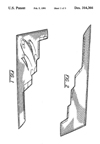
Patent Diagrams for the Northrop B-2 Strategic Bomber
Design Patent D-314,366
Click to Enlarge
Click Here to learn how to get free patent diagrams
Here is a video that gives an overview of the B-2 program.
Click Here for more information about the Northrop B-2 "Spirit".
Counter for the Entire Site (not just this page..)
Home | About Lindy | 1940s Collectibles | Upcoming Events | Vintage Clothing
The Guide - Establishments - Travel - Accessories
Music | Links | Photo Gallery | Extras | Contact